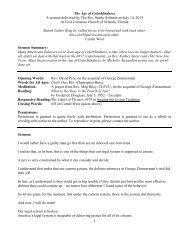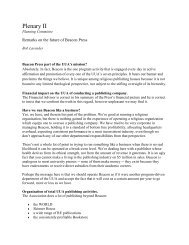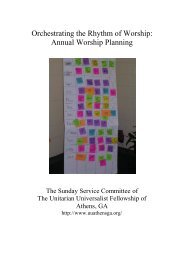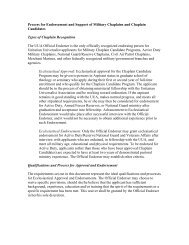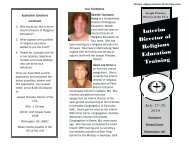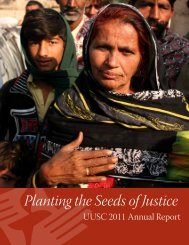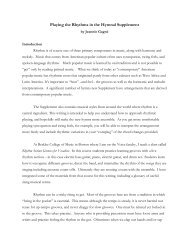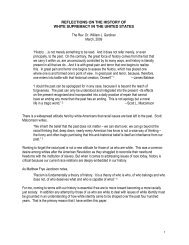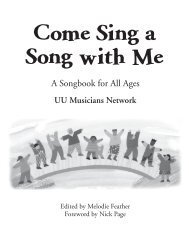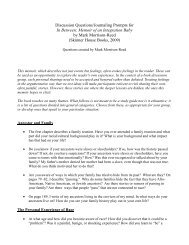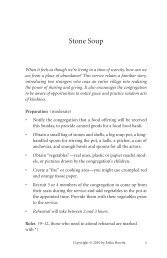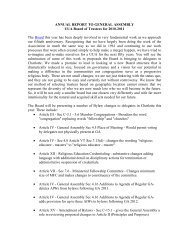Stages in Children's Development of Racial / Cultural Identity
Stages in Children's Development of Racial / Cultural Identity
Stages in Children's Development of Racial / Cultural Identity
You also want an ePaper? Increase the reach of your titles
YUMPU automatically turns print PDFs into web optimized ePapers that Google loves.
For: Sophia Lyon Fahs Lecture, UUA General Assembly 2012STAGES IN CHILDREN'S DEVELOPMENT OF RACIAL 1 / CULTURAL 2IDENTITY & ATTITUDESLouise Derman-SparksNOTE: The stage/age characteristics described here focus on salient aspects <strong>of</strong>racial/cultural identity and attitude development. These characteristics aregeneralizations, based on the behavior <strong>of</strong> many children. A particular child will show a few,some, or many <strong>of</strong> the characteristics <strong>of</strong> his/her age and stage.Infants‣ Gradually becom<strong>in</strong>g aware <strong>of</strong> self as a separate be<strong>in</strong>g.‣ Beg<strong>in</strong>n<strong>in</strong>g to absorb a cultural identity through daily care giv<strong>in</strong>g <strong>in</strong>teractions, householdsmell, sounds, etc. Beg<strong>in</strong>n<strong>in</strong>g to babble a range <strong>of</strong> sounds and imitat<strong>in</strong>g <strong>in</strong>tonationand sounds <strong>of</strong> the home language‣ Beg<strong>in</strong>n<strong>in</strong>g to notice and respond to sk<strong>in</strong> color cues ( around 6 months old)‣ Quality care/education programs provide cultural cont<strong>in</strong>uity with each <strong>in</strong>fant’s homeculture and some caregivers from <strong>in</strong>fants’ racial/cultural group.Ones and Twos‣ Cont<strong>in</strong>u<strong>in</strong>g to develop their awareness <strong>of</strong> self as separate <strong>in</strong>dividual‣ Learn<strong>in</strong>g to <strong>in</strong>teract with others with<strong>in</strong> the cultural rule system <strong>of</strong> theirfamilies. Pay close attention to “their” adults’ feel<strong>in</strong>gs and non-verbalmessages.‣ Curious about physical characteristics <strong>of</strong> self and others (sk<strong>in</strong> color, hair texture,gender anatomy); May “match” people based on physical characteristics.1 The concept <strong>of</strong> "race" is” biologically mean<strong>in</strong>gless, but, as a social-political construct thatunderlies systemic racism, “race” does deeply affect how societal <strong>in</strong>stitutions and <strong>in</strong>dividualsrespond to people. Consequently, sk<strong>in</strong> color plays an early part <strong>in</strong> young children's develop<strong>in</strong>gsense <strong>of</strong> self and others.2 Family culture is children is first socializ<strong>in</strong>g context, giv<strong>in</strong>g children a sense <strong>of</strong> identity anda set <strong>of</strong> beliefs, values, language and rules <strong>of</strong> behavior for <strong>in</strong>teract<strong>in</strong>g with the world. By 3years <strong>of</strong> age, dom<strong>in</strong>ant societal culture also <strong>in</strong>fluences children’s ideas, beliefs and behaviorsas they enter <strong>in</strong>to and learn from societal <strong>in</strong>stitutions, such as school, media, faith-based andcommunity sett<strong>in</strong>gs.1
For: Sophia Lyon Fahs Lecture, UUA General Assembly 2012‣ Sometimes show<strong>in</strong>g discomfort around unfamiliar people, <strong>in</strong>clud<strong>in</strong>g <strong>in</strong>dividualswith different sk<strong>in</strong> color. May not have language to express or ask aboutaspects <strong>of</strong> difference that <strong>in</strong>trigue them.‣ Beg<strong>in</strong>n<strong>in</strong>g to vocalize ‘words’ from her/his home language. By two identify<strong>in</strong>gself/others with words like "me", "m<strong>in</strong>e", "you"‣ Care/education program cont<strong>in</strong>ues <strong>in</strong>corporat<strong>in</strong>g home cultures and <strong>in</strong>troducesdiversity through books, posters, puzzles that are age appropriate.Threes and Fours‣ Speak<strong>in</strong>g and cont<strong>in</strong>u<strong>in</strong>g to develop their home language , a critical time fordevelopment <strong>in</strong> their home language‣ Becom<strong>in</strong>g grounded <strong>in</strong> their family/extended family's cultural ways <strong>of</strong> be<strong>in</strong>g: language, rulesabout behavior, how emotions are expressed, gender norms‣ Identify and match people accord<strong>in</strong>g to “racial” physical characteristics and groups,but <strong>of</strong>ten confused about complexities <strong>of</strong> group categories (e.g., "” How can twochildren with dark brown sk<strong>in</strong> be <strong>in</strong> different groups, e.g., African American andMexican American).‣ Can learn that sk<strong>in</strong> serves the same purpose for everyone, regardless <strong>of</strong> sk<strong>in</strong> color andappreciate that all colors are beautiful. Do not yet understand the concept <strong>of</strong> “melan<strong>in</strong>”‣ Not yet clear about gender and racial identity constancy ( e.g., will I always be aboy/girl; will I always have my sk<strong>in</strong> color?) ; Curious, and sometimes fearful aboutdisabilities and beg<strong>in</strong>n<strong>in</strong>g to show awareness <strong>of</strong> socio-economic class‣ Over-generalize and make <strong>in</strong>correct associations about differences based on theirlimited experience and still limited ways <strong>of</strong> process<strong>in</strong>g <strong>in</strong>formation. May havetheir own explanations for the differences they observe among people‣ Absorb societal stereotypes from people and from media about other groups andmay show discomfort or fear. May tease or refuse to play with others because <strong>of</strong>sk<strong>in</strong> color, language differences, and physical disabilities.‣ IN ADDITION, have a strong sense <strong>of</strong> empathy and <strong>in</strong>terest <strong>in</strong> fairness and canbeg<strong>in</strong> to develop critical th<strong>in</strong>k<strong>in</strong>g about hurtful images, comments and behaviors.‣ Beg<strong>in</strong> to show evidence <strong>of</strong> societal messages affect<strong>in</strong>g how they feel abouttheir self and /or group identity, i.e., evidence <strong>of</strong> beg<strong>in</strong>n<strong>in</strong>gs <strong>of</strong> <strong>in</strong>ternalizedsuperiority (IS) or <strong>in</strong>ternalized oppression ( IO)‣ Quality ECE programs foster: children’s self and group identities, <strong>in</strong>tegrate homecultures and support home language to extent possible, promote learn<strong>in</strong>g about2
For: Sophia Lyon Fahs Lecture, UUA General Assembly 2012each other’s home cultures and each other’s similarities and differences,<strong>in</strong>troduce critical th<strong>in</strong>k<strong>in</strong>g ( true/not true, fair/not fair) about pervasivestereotypes and teach skills for deal<strong>in</strong>g with hurtful behavior among themselves.Five and Sixes‣ Children whose home culture and experiences significantly differ from the dom<strong>in</strong>ant orma<strong>in</strong>stream culture <strong>of</strong>ten face a "bi-cultural" crisis upon enter<strong>in</strong>g school. (This may bewhite children from low-<strong>in</strong>come families, immigrant children, and children whose homeculture/language differs from school culture/language). Ways children beg<strong>in</strong> tohandle the “bi-cultural” crisis <strong>in</strong>clude:a. Reject<strong>in</strong>g home culture & learn<strong>in</strong>g dom<strong>in</strong>ant oneb. Reject<strong>in</strong>g school culture and <strong>in</strong>sist<strong>in</strong>g on home culturec. Learn<strong>in</strong>g to code switch and to become bi-cultural‣ Aware <strong>of</strong> and explor<strong>in</strong>g mean<strong>in</strong>g <strong>of</strong> the several aspects <strong>of</strong> their self and/or groupidentities (racial, cultural, gender,) and the societal messages about them.Develop gender and racial constancy‣ Interested <strong>in</strong> how people get sk<strong>in</strong> color and can understand simple scientificexplanations about sk<strong>in</strong> color differences‣ Show evidence <strong>of</strong> societal messages affect<strong>in</strong>g how they feel about their self and/or group identity, i.e., evidence <strong>of</strong> beg<strong>in</strong>n<strong>in</strong>gs <strong>of</strong> <strong>in</strong>ternalized superiority (IS) or<strong>in</strong>ternalized oppression ( IO)‣ May select to play only with children close to their gender and racial/culturalidentities, but may also reject members <strong>of</strong> their own racial/cultural group (e.g.darker sk<strong>in</strong>ned African American children, Spanish-speak<strong>in</strong>g Lat<strong>in</strong>o children)‣ May use prejudicial <strong>in</strong>sults and name-call<strong>in</strong>g to show anger or aggression, know<strong>in</strong>gthat these terms hurt.‣ However, do enjoy explor<strong>in</strong>g the similarities and differences <strong>in</strong> the home cultures<strong>of</strong> their peers/classmates and can identify stereotypes, develop critical th<strong>in</strong>k<strong>in</strong>gskills, and engage <strong>in</strong> “social justice” activities on issues that directly touch them--<strong>in</strong> their classroom, school and neighborhood.‣ Quality primary programs <strong>in</strong>corporate the four anti-bias education goals <strong>in</strong>to thedaily curriculum. Fives and sixes pr<strong>of</strong>it from the objectives described forpreschoolers. They can apply learn<strong>in</strong>g about similarities and differences tocreat<strong>in</strong>g behavioral “rules” for their classroom and to simple activism activitiesaddress<strong>in</strong>g hurtful prejudice or discrim<strong>in</strong>ation affect<strong>in</strong>g themselves and theirclassmates.Sevens, Eights & N<strong>in</strong>es‣ Establish<strong>in</strong>g group identities and membership -<strong>of</strong>ten form groups to act with<strong>in</strong> own cultural3
For: Sophia Lyon Fahs Lecture, UUA General Assembly 2012rules and to re<strong>in</strong>force sense <strong>of</strong> group identity. Able to learn to consciously codeswitchbetween home/community and school cultures‣ Children <strong>of</strong> color aware <strong>of</strong> racism aga<strong>in</strong>st own racial/ cultural group. May shownegative impact <strong>of</strong> <strong>in</strong>ternalized racism: third grade is when many children "psychologically"drop out <strong>of</strong> school (Their bodies are <strong>in</strong> the classroom, but their m<strong>in</strong>ds are elsewhere).‣ See rise <strong>in</strong> name-call<strong>in</strong>g based on racial, gender, class, disability and sexualorientation identities. Show <strong>in</strong>fluence <strong>of</strong> dom<strong>in</strong>ant culture myths about class (be<strong>in</strong>gpoor is the <strong>in</strong>dividual's choice/ fault; hav<strong>in</strong>g money is a sign <strong>of</strong> superior abilities).However, they also now have a greater capacity for empathy about the hurtname-call<strong>in</strong>g causes.‣ Can identify and critically th<strong>in</strong>k about <strong>in</strong>terpersonal dynamics <strong>of</strong> racism, sexism andclassism, and how to <strong>in</strong>terrupt them. Understand scientific explanations for sk<strong>in</strong>color and how <strong>in</strong>dividuals get their sk<strong>in</strong> color. Understand nature and harm <strong>of</strong>stereotyp<strong>in</strong>g.‣ Like to learn about the “history” <strong>of</strong> their own people and communities. ( Interview<strong>in</strong>g peopleand writ<strong>in</strong>g about them are popular activities that also build literacy skills)‣ Role models <strong>of</strong> people active <strong>in</strong> anti-racism /social justice struggles very important tothem. Can engage <strong>in</strong> group activities to challenge <strong>in</strong>dividual and cultural forms <strong>of</strong> racism<strong>in</strong> their community‣ Quality educational programs use children’s greater cognitive abilities tounderstand their self and group identities, while also foster<strong>in</strong>g children’sempathy for people across differences and their critical th<strong>in</strong>k<strong>in</strong>g and act<strong>in</strong>gskills for counter<strong>in</strong>g prejudice and discrim<strong>in</strong>ation . It is important to teach aboutpeople <strong>in</strong> their and each others communities who work to end prejudice anddiscrim<strong>in</strong>ation. All aspects <strong>of</strong> curriculum make visible the contributions <strong>of</strong> allracial/cultural groups.BE AWAREBy age 9, "when faced with counter-stereotypic <strong>in</strong>formation, children that showed highlystereotyped attitudes tended to forget that <strong>in</strong>formation, or, even more disturb<strong>in</strong>gly, to distort it<strong>in</strong> memory to make their ideas consistent with their stereotyped beliefs” (Bigler & Liben, 1993,Child <strong>Development</strong>)."After age 9, racial attitudes tend to stay constant unless the child experiences a life-chang<strong>in</strong>gevent" (Frances Aboud, Children & Prejudice, NY: Basil Blackwell, 1988).Tens, Elevens, Twelves4
For: Sophia Lyon Fahs Lecture, UUA General Assembly 2012‣ Want to learn more <strong>in</strong>-depth <strong>in</strong>formation about their cultural group and its true history.Role models <strong>of</strong> people who made contributions and also worked to end <strong>in</strong>justices arevery important to them.‣ Aware <strong>of</strong> differences <strong>in</strong> perspective between dom<strong>in</strong>ant culture and their own group'sculture. (e.g., "They (dom<strong>in</strong>ant culture) th<strong>in</strong>k about us this way...; we th<strong>in</strong>k about ourselves <strong>in</strong>other ways...)‣ Cont<strong>in</strong>ue to show impact <strong>of</strong> learned mis<strong>in</strong>formation, stereotyp<strong>in</strong>g and dislike <strong>of</strong> otherracial/cultural groups. However, have the cognitive ability to exam<strong>in</strong>e these more objectivelywith new <strong>in</strong>formation and can compare & contrast two different perspectives <strong>in</strong> an issue‣ Conscious <strong>of</strong> and <strong>of</strong>ten disturbed by contradictions between what significant adults(e.g., family, teachers, religious figures) say and do about racial issues.‣ Need a place to voice their concerns about <strong>in</strong>justices they see <strong>in</strong> their own lives’, <strong>in</strong>their communities <strong>in</strong> the media. beg<strong>in</strong> to understand concrete forms <strong>in</strong>stitutionalracism‣ Interested <strong>in</strong> history and geography, if it deals with real people; becom<strong>in</strong>g aware <strong>of</strong>and <strong>in</strong>terested <strong>in</strong> world events‣ Interested <strong>in</strong> learn<strong>in</strong>g about current and past people who engaged <strong>in</strong> a range <strong>of</strong> anti-racistand other social justice activities from all racial/cultural groups‣ Can engage <strong>in</strong> anti-racist activities <strong>in</strong> their community related to their understand<strong>in</strong>g and<strong>in</strong>terests (e.g., help<strong>in</strong>g an anti-racist or other social justice focused communitygroup with their work)‣ Unless middle school children have had quality diversity and equity education <strong>in</strong>previous years, they will show the negative affects <strong>of</strong> racism on their identities andattitudes towards others. However, they also have the cognitive and emotionalcapacities to benefit from work<strong>in</strong>g on the four anti-bias goals as they relate to theirown lives and <strong>in</strong> the various school subjects. Middle-school children also quickly pickupteachers and school policies “talk<strong>in</strong>g’ but not “walk<strong>in</strong>g” the diversity/equity path.Adolescence and Young Adulthood‣ Attitudes toward self and other groups are well established. So, too, is a strong sense <strong>of</strong>fairness and justice, although it may lie dormant <strong>in</strong> school sett<strong>in</strong>gs.‣ With opportunities to honestly voice their life narratives, and accurate knowledge abouttheir own and other groups, can apply their critical th<strong>in</strong>k<strong>in</strong>g and sense <strong>of</strong> fairness tochang<strong>in</strong>g attitudes and behaviors. However, many may have to overcome lack <strong>of</strong>tra<strong>in</strong><strong>in</strong>g/experience <strong>in</strong> critical th<strong>in</strong>k<strong>in</strong>g.‣ Have the capacity to understand fully how cultural and <strong>in</strong>stitutional racism5
For: Sophia Lyon Fahs Lecture, UUA General Assembly 2012<strong>in</strong>ternalized superiority and <strong>in</strong>ternalized oppression work. Can engage <strong>in</strong> criticalexam<strong>in</strong>ation <strong>of</strong> their own beliefs, cross-racial/cultural dynamics and developempathetic connections and <strong>in</strong>teractions‣ Rework<strong>in</strong>g <strong>of</strong> personal and group identity can go <strong>in</strong> positive or negative directions.---Adolescents/young adults -<strong>of</strong>-color may: (a) Reclaim their identity/history; (b) Act out<strong>in</strong>ternalized racism aga<strong>in</strong>st themselves and others, or, (c) Show aspects <strong>of</strong> both.---White adolescents/young adults may: (a) Reject/deny anti-racism teach<strong>in</strong>g and activelycarry out racism <strong>in</strong> speech and <strong>in</strong> behavior (e.g., name-call classmates, jo<strong>in</strong> groupssuch as the Sk<strong>in</strong> Heads); (b) <strong>in</strong>sist on a “color-bl<strong>in</strong>d” stance , passively (conformity)participat<strong>in</strong>g <strong>in</strong> racism; (c) Reject white racism (as they understand it) and try to developan anti-racist identity and behavior‣ Learn<strong>in</strong>g accurate history about all groups <strong>of</strong> people, as well as accurate history <strong>of</strong>racism and anti-racism plays a crucial role <strong>in</strong> choos<strong>in</strong>g positive personal and groupidentity.,‣ Work<strong>in</strong>g on social justice issues appeals to adolescent/young adults critiques <strong>of</strong> their societythe may also show <strong>in</strong>terest <strong>in</strong> the <strong>in</strong>justices <strong>in</strong> other parts <strong>of</strong> the world. Theirpassionate sense <strong>of</strong> justice can positively nurture their sense <strong>of</strong> power <strong>in</strong> the world.‣ Great capacity to commit to and help organize creative anti-racism/social justiceaction <strong>in</strong> their community. May need guidance to keep realistic. Remember that itwas adolescents and young adults who were the heart <strong>of</strong> the great civil rightsmovement <strong>of</strong> the sixties.‣ High school and two or four-year colleges can capitalize on the strengths <strong>of</strong>adolescents and young adults <strong>in</strong> all aspects <strong>of</strong> the curriculum. Specific courses <strong>in</strong>ethnic studies and social justice history, as well as community service work are alsovery useful.6



